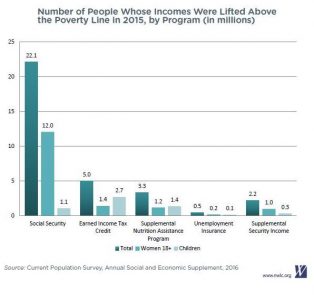Public social insurance and safety net programs are critical to the economic security of women and families. Some of these programs are counted in the official poverty measure and lift millions of people out of poverty. Others, primarily non-cash benefits like the Supplemental Nutrition Assistance Program (SNAP, formerly Food Stamps) and tax credits like the Earned Income Tax Credit (EITC), are not counted in the official poverty measure but boost the incomes of millions above the poverty line.
Social Security, the EITC, SNAP, unemployment insurance, and Supplemental Security Income (SSI) are five key programs that lifted families’ incomes above the official poverty line in 2015. Together, these programs lift millions of people out of poverty every year.
Notably, funding for all of these programs is designed to adjust automatically when eligibility increases. During economic downturns, programs like SNAP and unemployment insurance expand to meet greater need; these programs served as critical lifelines for millions of families during and following the Great Recession. In contrast, funding for block grant programs like Temporary Assistance for Needy Families (TANF) typically falls over time, even when need rises. Core funding for the TANF block grant has been frozen since its enactment in 1996, and TANF failed to serve as an adequate safety net during the recession or its aftermath. Today, TANF serves only 23 of every 100 families with children that live below the poverty line.
Programs like Social Security, the EITC, SNAP, unemployment insurance, and SSI work, moving millions of women and children out of poverty and improving the economic security of millions more. We must protect and strengthen these effective anti-poverty vehicles—not block grant or otherwise cut them.
- Social Security is a social insurance program that protects workers and their families when income is lost due to a worker’s retirement, disability, or It covers nearly all workers and their families, and while it is not just for those with low incomes, it is the nation’s most successful anti-poverty program. In 2015, Social Security lifted nearly 22.1 million people out of poverty, including:
- Nearly 15.1 million people 65 and older, including more than 8.9 million older women;
- More than 5.9 million adults 18-64, including nearly 3.1 million women; and
- Nearly 1.1 million children.
- The EITC supplements wages for low- and moderate- income working families. If counted in the official poverty measure, the EITC would have lifted the incomes of nearly 5 million people above the poverty line in 2015, including:
- Nearly 2.3 million adults 18 and older, including more than 1.4 million women; and
- More than 2.7 million children.
- SNAP benefits help millions of families put food on the table. If counted in the official poverty measure, SNAP would have lifted the incomes of more than 3.3 million people above the poverty line in 2015, including:
- Nearly 336,000 people 65 and older, including nearly 221,000 older women;
- More than 1.6 million adults 18-64, including nearly 960,000 women; and
- Nearly 1.4 million children.
- Unemployment insurance benefits provide temporary income support to eligible jobless workers who have lost employment through no fault of their own. Unemployment insurance kept more than 488,000 people from falling into poverty in 2015, including:
- Nearly 353,000 adults 18 and older, including nearly 181,000 women; and
- More than 135,000 children.
- SSI provides income support for low-income individuals who are elderly or living with SSI lifted more than 2.2 million people out of poverty, including:
- Nearly 467,000 people 65 and older, including more than 261,000 women;
- Almost 1.4 million adults 18-64, including more than 720,000 women; and
- More than 337,000 children.

